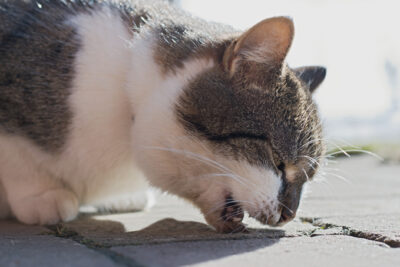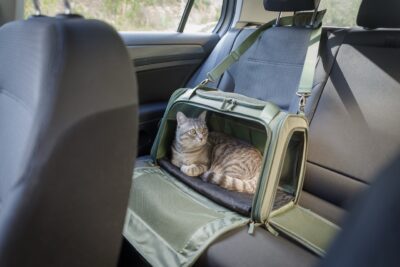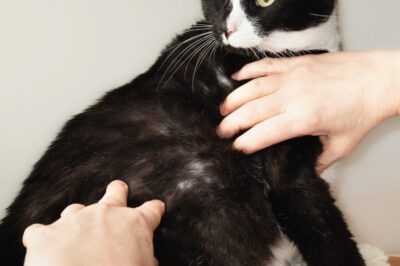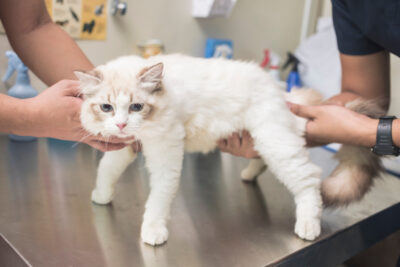Is Your Cat Throwing Up Brown Liquid? What To Do

Overview
As a veterinarian and cat parent, I have seen my fair share of vomiting cats over the years. And I can tell you first hand: The wide range of colors and consistencies cats can spew is quite impressive! In many cases, cat puke isn’t necessarily cause for concern. However, a cat throwing up brown liquid could be a warning sign worth heeding.
Brown cat vomit can be a sign of a life-threatening health issue, such as pancreatitis or kidney disease. Or, it could be due to something much less worrisome, like a hairball or upset stomach.
Unfortunately, often the only way to know for sure what you’re dealing with is through diagnostic testing. And how many pet parents want to rush to the clinic every time their cat yacks up a brownish mess?
When your cat’s health is in question, a veterinary visit is always your best bet. However, there may be some scenarios where it’s reasonable to monitor your cat at home. Telling the difference between the two is the hard part. Here’s some guidance, so you can make the right choice for a cat vomiting brown liquid.
Brown Cat Throw-up: What it Looks Like

In the rainbow array of cat puke colors, brown throw-up is pretty common for most felines. Many cat foods are brownish in color. So if your cat is throwing up partially digested food, it will often be some shade of brown or tan.
Brown vomit in cats may be solid, liquid, or somewhere in between. It may range in color from dark to light brown or appear yellowish, reddish, or greenish in hue. It can contain brown or dark brown liquid, brown foam, brown specks, and/or brown mucus. A cat vomiting bile can also look like brown liquid.
In general, brown puke is not necessarily a cause for concern in cats. However, if your cat’s vomit has brown specks in it or looks like it contains coffee grounds, it’s an important warning sign. This can indicate the presence of digested blood in the vomit. In that case, an immediate visit to the vet is in order.
Causes of Brown Vomit in Cats

Cats throw up for many reasons, ranging from minor issues to severe health conditions. Potential causes of a cat throwing up brown liquid or brown vomit can include:
- Hairballs
- Dietary sensitivity
- Intestinal parasites
- Heartworm disease
- Feline infectious peritonitis
- Feline panleukopenia
- Toxin (antifreeze, poisonous plants)
- Medication reaction
- Foreign body obstruction
- Constipation
- Stomach ulcers
- Inflammatory bowel disease
- Intestinal tumor (e.g., lymphoma)
- Hyperthyroidism
- Kidney disease
- Liver disease
- Diabetes
- Neurologic disease
Unfortunately, you can’t tell too much from the color and appearance of cat vomit to know what’s causing it. To answer the question, “Why is my cat puking?” typically requires a veterinary exam and specific diagnostic tests.
Cat Throwing Up Brown Liquid: Is It Cause for Concern?

In general, a single, isolated episode of cat vomit is rarely cause for concern. However, since brown vomit can signal internal bleeding in cats, it’s worth taking more seriously. Here’s how to know when to seek veterinary attention for a cat throwing up brown liquid.
For a cat vomiting brown liquid with specks in it that look like coffee grounds, go to the nearest veterinarian as soon as possible. This is not a “wait and see” situation. Those specks could indicate blood in your cat’s gastrointestinal tract, which is a serious health issue
If your healthy, adult cat vomited brown liquid just once, it could be an isolated incident. A brief period of stomach rest often resolves the problem. Restrict their access to food and water for the next two to three hours and observe them closely.
If your cat doesn’t throw up again and they are otherwise acting fine, there’s no need to rush them to the vet. However, if they vomit repeatedly or display any of the following signs, visit your vet or a nearby emergency veterinary hospital right away.
Warning signs to watch out for:
- Lethargy (lack of energy)
- Diarrhea
- Repeated or projectile vomiting
- Abdominal pain
- Not eating or drinking for longer than 12 hours
- Straining in the litter box
- Change in litter box habits
- Hiding from people
- Unexpected aggression in a friendly cat
- Other behavioral changes
A cat vomiting brown liquid intermittently — even without any other signs of illness — should also visit the vet. What could seem like isolated incidents may be more than that if they happen repeatedly. In general, any cat that vomits more than once weekly should see a veterinarian for a full exam.
Finally, these guidelines only apply to healthy, adult cats. If your cat has an underlying illness and begins vomiting, contact your veterinarian for guidance. If a young kitten begins vomiting, seek veterinary care as soon as possible. Unhealthy cats and young kittens are at higher risk of dehydration and other serious consequences caused by vomiting.
Treatment for Cat Vomiting Brown Liquid

To treat a cat vomiting brown liquid, your vet must first diagnose the underlying cause. This requires a thorough medical history, so it’s a good idea to come to the appointment with info about:
- your cat’s diet
- any other health issues they have
- what preventatives they’re on
- the frequency, appearance, and color of your cat’s vomit
Next, your veterinarian will perform a thorough physical examination to evaluate your cat’s overall health. They will look for signs of dehydration, abdominal pain, abdominal masses, and other abnormalities.
If needed, your vet will recommend diagnostic tests for your cat. These could include a test for fecal parasites, blood tests, abdominal X-rays, and an abdominal ultrasound.
Treatments for a cat throwing up brown liquid will vary depending on the cause. Veterinarians commonly recommend anti-nausea medication (such as maropitant) and fluid therapy to treat or prevent dehydration. In cases of a serious underlying disease, hospitalization may be required.
Other potential treatments for vomiting in cats may include:
- Dewormer (for cats with intestinal parasites)
- Surgery (for cats with an intestinal obstruction)
- Thyroid medication (for cats with hyperthyroidism)
- Insulin (for cats with diabetes)
- Chemotherapy (for cats with gastrointestinal lymphoma)
My Take on Brown Cat Vomit

I live with two cats, and I’m well aware that “vomit happens!” Fortunately, most incidents have been isolated. My cats have yet to have an episode of vomiting with a serious underlying cause. (I’m knocking on wood right now!)
When I discover cat vomit in my home, I stay on heightened alert for a day or two. I watch my cats closely, looking for signs of illness and any additional evidence of vomiting episodes. In most cases, everything is fine, and I don’t have to worry about it further.
In those rare situations where the vomiting persists, or if my cat is acting unwell, I take them to the veterinary hospital for a workup. This typically includes a physical exam, blood tests, and an abdominal X-ray.
As long as these tests come back normal, my cat gets an anti-nausea injection and the vomiting resolves quickly.
Every cat is different, however. So if you’re ever in this situation, your veterinarian can help guide you through the process to restore your cat’s good health. In some cases, that may require a change in diet. In other cases, more aggressive treatment may be merited.
The most important thing is to know when it’s crucial to take a cat vomiting brown liquid to the vet for proper care. As long as you know the key warning signs to look for, you can make sure your cat’s health is in the best hands possible.









